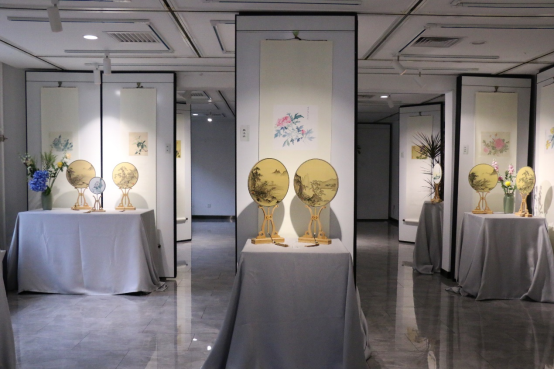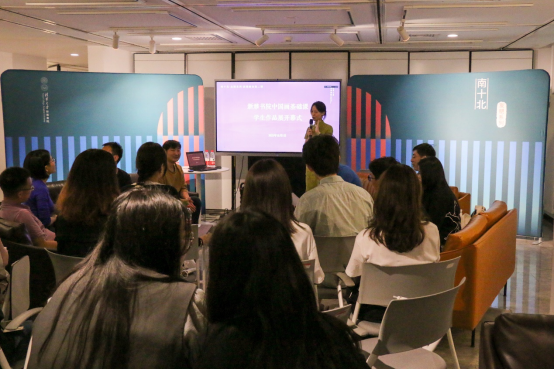On the afternoon of October 1, 2022, when the students returned to the hall on the first floor at the North Wing of Building 10, Xinya College, they were attracted by the round fans and silk paper with colored paintings under the spotlight. These works seem to carry a tension of calm and surging. Immediately, visitors will be immersed into the poetry and painting scenes featuring landscapes, flowers, birds, pavilions, terraces and towers.

Around the theme of replication, all the exhibits are the works of Xinya students in the basic courses of Chinese painting. In the fall semester of 2021 and the spring semester of 2022, Zhao Tianye and Chen Sanyin offered the Basic Course of Chinese Flower and Bird Painting and the Basic Course of Chinese Landscape Painting respectively at Xinya College. By copying classic works such as the Scroll of Hundred Flowers by Yun Nantian in Qing Dynasty, Pine Wind Pavilion by Ma Yuan in Song Dynasty, and Residing by Secluded Lake by Xia Gui in Song Dynasty, many students who had no idea of Chinese painting used brush and ink to express their poetic feelings during replication and creation.
On the afternoon of October 1, teachers and students of the Chinese painting courses at Xinya College gathered in the hall for the opening ceremony of the exhibition. Mei Ciqi, Dean of Xinya College, and Zhang Weite, Deputy Dean of Xinya College, arrived in advance and praised the works of the students. Guests inside and outside Tsinghua University, course teachers, members of the administrative council of Xinya College, and exhibitors attended the opening ceremony, which was hosted by Jin Siyu (a student of the aforementioned two courses).

After the host introduced the courses, Mei delivered an opening speech. First of all, Mei expressed gratitude to the two teachers for their efforts in the courses and congratulations on the smooth opening of the exhibition. He compared the farm work in the morning with the landscape painting exhibition in the afternoon. In labor and aesthetic education, Xinya students understand and care for the world in their own way. In the practice of Chinese painting creation, students noticed the beauty and realized the significance of creation in the challenging study. Mei emphasized the significance of developing a spectrum of activities at Xinya College. He hoped that students can participate in diversified courses and activities, explore various possibilities in the world, and have a more in-depth understanding of the world, so as to embrace new things and finally achieve what they want to do in them.
Next, the two course teachers made speeches. Zhao Tianye shared the three key points in the Basic Course of Chinese Flower and Bird Painting, namely, focusing on foundation and tradition, paying attention to cultural communication, and creating one's own art space in the traditional aesthetics of China. She hoped that after the course, students can be promoters of traditional Chinese culture and bring the beauty of traditional arts they feel to their schoolmates and friends, so that more people can understand Chinese culture. Chen Sanyin highly praised the students' abilities in Chinese painting creation after systematic learning, and emphasized that Chinese painting, as a combination of humanistic ideas and traditional aesthetic ways, shows the development process and spiritual connotation of Chinese culture.
Song Xiaoyi and He Runqi, students of the Basic Course of Chinese Flower and Bird Painting in 2021, and Gu Ruotong and Zhang Haoran, students of the Basic Course of Chinese Landscape Painting in 2022, expressed their thoughts on the courses respectively. Song Xiaoyi told her experience of creating peach blossoms in winter. It was wonderful to witness the flowers blooming bit by bit with the warming of the weather. She shared the beauty that paintings of peach blossoms represent and a completely new look that landscape paintings reveal. "My favorite is the fresh and elegant mountains and rivers with no sorrows of the world." She thought a good Chinese painting should be a combination of love and will. He Runqi experienced the spiritual realm where lush mountains reach far and still waters run deep when he outlined the landscape with his brush strokes. He believed that painting is a process of revealing one's heart. A Chinese painting, like an old friend by tacit agreement, waits for you with the bright moon and fresh breeze. Gu Ruotong was impressed by the teacher's request to copy with one's own character and ingenuity. After spending many afternoons in the painting studio, she learned to create and appreciate a Chinese painting. Zhang Haoran compared the creation techniques of Chinese paintings and watercolors and the philosophical concepts behind them, shared his understanding of the way predecessors observed the world during the creation of landscape paintings, and expressed his intention to carry forward such a cultural spirit.
After the students' speeches, Gu Tao, deputy dean of Rixin College, Tsinghua University, and Gao Dengke, a teacher from the university's Academy of Arts & Design, commented on the Chinese painting courses and the students' works. Gu Tao first mentioned that the true, the good and the beautiful should be pursued in every discipline. Xinya's Chinese painting courses combine professional study with pursuit of beauty, allowing students to have a deeper understanding of Chinese traditional culture and the inner feelings of Chinese people. Gu hoped that students can stop and think about their gains in their academic pursuit, slow down like painting landscape, and immerse themselves in it for a further understanding. He looked forward to more cooperation between Xinya College and Rixin College. Gao Dengke praised that the layout of the exhibition not only shows the order but also the sense of amity. He emphasized the fundamentality of replication in the study of painting. Only by starting from the expression of physical feelings in specific time and space can we create a vivid painting. Gao added that painting and farm work are both body memories. The general education of Xinya College provides an opportunity for students to build a cultural cognition from their own genes.
At the end, all the guests visited the painting exhibition together. Several students explained the artistic conception in their paintings to them. The opening ceremony ended with the happy free exchanges between teachers and students.